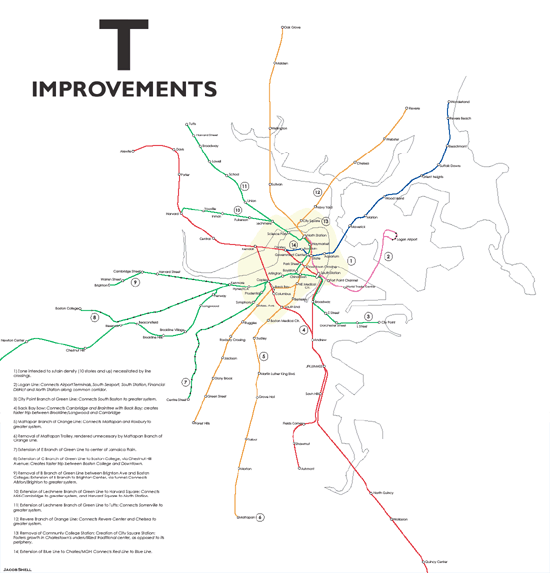
Jacob Shell, 2003
download:
.PDF (273k)
From: "Jacob Shell"
To: "Bill Rankin"
Sent: Thursday, December 18, 2003 9:51 AM
Subject: Re: cartography
Hi Bill,
I'm still not sure I agree with the idea of surrounding downtown boston with ring lines. The Back Bay Bow which I propose is intended not so much as a ring as an acknowledgement that the Copley Square area has become every bit as important a regional center as the financial district. To this end, the Back Bay does have considerable density — the towers around Copley and the Pru.
There is a fundamental question here of who, and what, a rapid transit system is for. My proposal is seeking to get people from residential areas to commercial centers or activity hubs — hence, the importance of strengthening the centrality of both North and South Stations, the city's mass-transit links to the suburbs.
I reconginize that ring roads like Harvard Street in Brookline are very clogged with car traffic, but this traffic emerges from trip-types that mass transit would not support: people driving from suburban areas to the south and east to suburban areas to the north and west. The only house-to-work type link fostered by this route is from Harvard to Longwood. I considered putting in a line that might strengthen this link, but felt that such a line, which would serve ONLY harvard affiliates, would defeat the purpose of a metropolitan network, which is to serve people from different walks of life.
The issue of density IS, i feel, very important — Boston's economy, unprecedently strong in the mid-90s, has been stagnant since 98. This occured because gwoth on the periphery was essentially halted — towns across eastern massachusetts got sick of giving over swaths of the environment to suburban development.
If boston is to grow, and at the same time preserve open space in its suburbs, it must foster growth near the underutilized center of the city, and in underutilized commuter railroad stops. Areas like Robury, Blue Hill Ave, the South Seaport, South Boston, and Somerville, must become denser (though architecturally valuable areas like the Back Bay would could be preserved in their current state — these areas tend to be dense anyway), while North and South station become more effective gateways.
Subways, as I understand them, demand density. The "web" model of the NYC Subway system indicates New York's tremendous density throughout. The denser the web, the denser the city.
I am not familiar with Basel. Is it a car-free city? Though I personally dislike cars, I wonder if its realistic to imagine a car-free city in America. Also, I wonder if the notion of the carfree city doesnt at some level sell short the possible benefits of cars — how can one carry heavy luggage on a subway?
Hoping to hear from you soon.
Jacob
